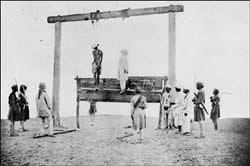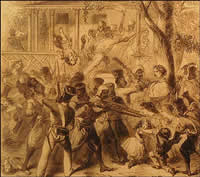The 1857 uprising
By Ishtiaq Ahmed
The News, May 09, 2007
 The month of May 2007 marks the 150th anniversary of a popular uprising in the Indian subcontinent against the English East India Company. It has been described as the Sepoy Mutiny by British writers because it originated among the native soldiers employed and trained by the Company. The sipahis (Urdu-Hindi word for soldiers) were dissatisfied with the way the British officers treated them, and were particularly enraged over the introduction of a cartridge, allegedly laced with cow and pig fat, to be used in the new Enfield rifles. It had to be chewed open and the gunpowder was poured into the rifle. Both Hindu and Muslim sipahis found such a procedure disgusting since those fats subverted their rules of purity.
The month of May 2007 marks the 150th anniversary of a popular uprising in the Indian subcontinent against the English East India Company. It has been described as the Sepoy Mutiny by British writers because it originated among the native soldiers employed and trained by the Company. The sipahis (Urdu-Hindi word for soldiers) were dissatisfied with the way the British officers treated them, and were particularly enraged over the introduction of a cartridge, allegedly laced with cow and pig fat, to be used in the new Enfield rifles. It had to be chewed open and the gunpowder was poured into the rifle. Both Hindu and Muslim sipahis found such a procedure disgusting since those fats subverted their rules of purity.
There were a number of local rebellions among the sepoys in Bengal already in early 1857, which were crushed and the rebel leaders hanged. Similar incidents took place elsewhere. The revolt climaxed when the sepoys in Meerut rose in arms on May 9-10, 1857. They killed their officers and called for a general mutiny. The rebels proclaimed the Mughal Emperor, Bahadur Shah Zafar, as their sovereign and demanded the British to leave India. Meerut, Delhi, Lucknow, Kanpur, Jhansi and Bereilly were the main centres of revolt.
Some rulers of princely states also joined the uprising. Under the Doctrine of Lapse introduced by the Company it could annex states under its protection if the ruling family had no male heir to succeed. Some rulers had no male heir to succeed them. Other disgruntled forces that joined the movement were local leaders and warlords. The descendants of Shah Waliullah issued a fatwa calling it a jihad. But most rulers of princely states, Hindus and Muslims, kept away or even sided with the British.
The Sikh warlords and princes also sided with the British. Only eight years earlier in 1849 the English had defeated the successors of Ranjit Singh (1799-1839) and annexed the Sikh Kingdom of Lahore. The Company had deployed soldiers from northern India, called Purbi Bhiyas, against the Sikh armies. Now, the British played upon Sikh anger against the Purbi Bhiyas and made them crush the sepoys with a vengeance. Also, Muslim tribal and clan leaders from the Punjab and the NWFP helped the British. Afterwards all of them were rewarded with titles and land grants.
But not all Punjabis sided with the British. In some places there were uprisings. On January 4, 2005 I interviewed Maulana Habibur Rahman Sani in the main Friday mosque in Field Ganj, Ludhiana, East Punjab (currently there is a sizable Muslim labour force from Bihar and the UP in Ludhiana). Maulana Sani's grandfather, Maulana Habibur Rahman, was one of the founders and main leaders of the Majlis-e-Ahrar. He told me the fascinating story of his ancestor, Shah Abdul Qadir Ludhianvi, who he said led the revolt in the Punjab against the Company.
I was told that Shah Abdul Qadir Ludhianvi was able to drive out the British from Ludhiana. He took his forces to Panipat and from there to Chandni Chowk in Delhi, but was defeated and died fighting. Maulana Sani's theory was that because Shah Abdul Qadir was an Arain the British later put a ban on that tribe from being employed in their Indian army.
In any event, the rebels lacked coordinated leadership and the participation of the people was sporadic. There was no clarity on ideology beyond the common programme of driving the British out of India. Ultimately the Company fought back and regained its pre-eminent position in India. Bahadur Shah Zafar was sent into exile to Rangoon. His sons and many other relatives were captured and killed. All this was done in a most brutal and vicious manner.
In a hundred years -- from the battle of Plassey of 1757 to the uprising of 1857 -- the English East India Company had extended its power in all of northern India while it had become the main power in the south even earlier.
The gold, silver, precious stones and other riches transferred during that period helped to a point to finance the British industrial revolution. Thus by 1833 the Board of Directors of the East India Company had been transformed from one dominated by importers to exporters.

Some radical scholars believe that India was ripe for large-scale production. Had its wealth not been taken away it would have successfully entered the era of industrial production. Some people even suggest that literacy was as high as 85 per cent and 20-25 per cent of world trade originated in the subcontinent (it is 1 per cent at present for all of South Asia while the region is house to 25 per cent of the total world population). I have not been able to find reliable data to support these claims but there is no doubt that it was the wealth of India that brought the Europeans to it.
The 1857 uprising profoundly transformed the nature of British rule. India was formally annexed by the Crown in 1858 and became a part of the empire. Thus began the process of integration of different parts of India into a modern bureaucratic state. The new centres of political revival and economic activity were not the old towns and cities of northern India but coastal towns such as Madras, Bombay and Calcutta -- all located in Hindu majority areas.
The Indian National Congress, founded originally in 1885 on British prompting to counter the radical terrorist tendencies in Bengal, later began to organise mass opposition to colonial rule under the leadership of Mahatma Gandhi. In turn the British played upon the fears of the Muslim minority and encouraged them to found the All-India Muslim League in 1906. But all such machinations could not prolong British rule beyond mid-August 1947, when two independent states of India and Pakistan came into being.
Indian nationalists, who until 1947 included Hindus, Muslims, Sikhs and others, celebrated the 1857 uprising as the First Independence Struggle, some used stronger words such as the 'First War of Independence'. Their main argument is that those who took part in that struggle wanted an end to alien rule; they were seeking to restore the Mughal Emperor, Bahadur Shah Zafar, as the emperor of all the people of India.
They were not looking for the establishment of a Hindu Rashtra or an Islamic Caliphate. Therefore, the argument goes, it was a manifestation of a genuine desire to be free as a pluralist nation comprising all communities. Whatever the truth, I think some symbolic gesture to mark the 1857 uprising must be made jointly by India, Pakistan and Bangladesh.
The writer is professor of political science at the University of Stockholm, Sweden. Email: Ishtiaq.Ahmed-@statsvet.su.se